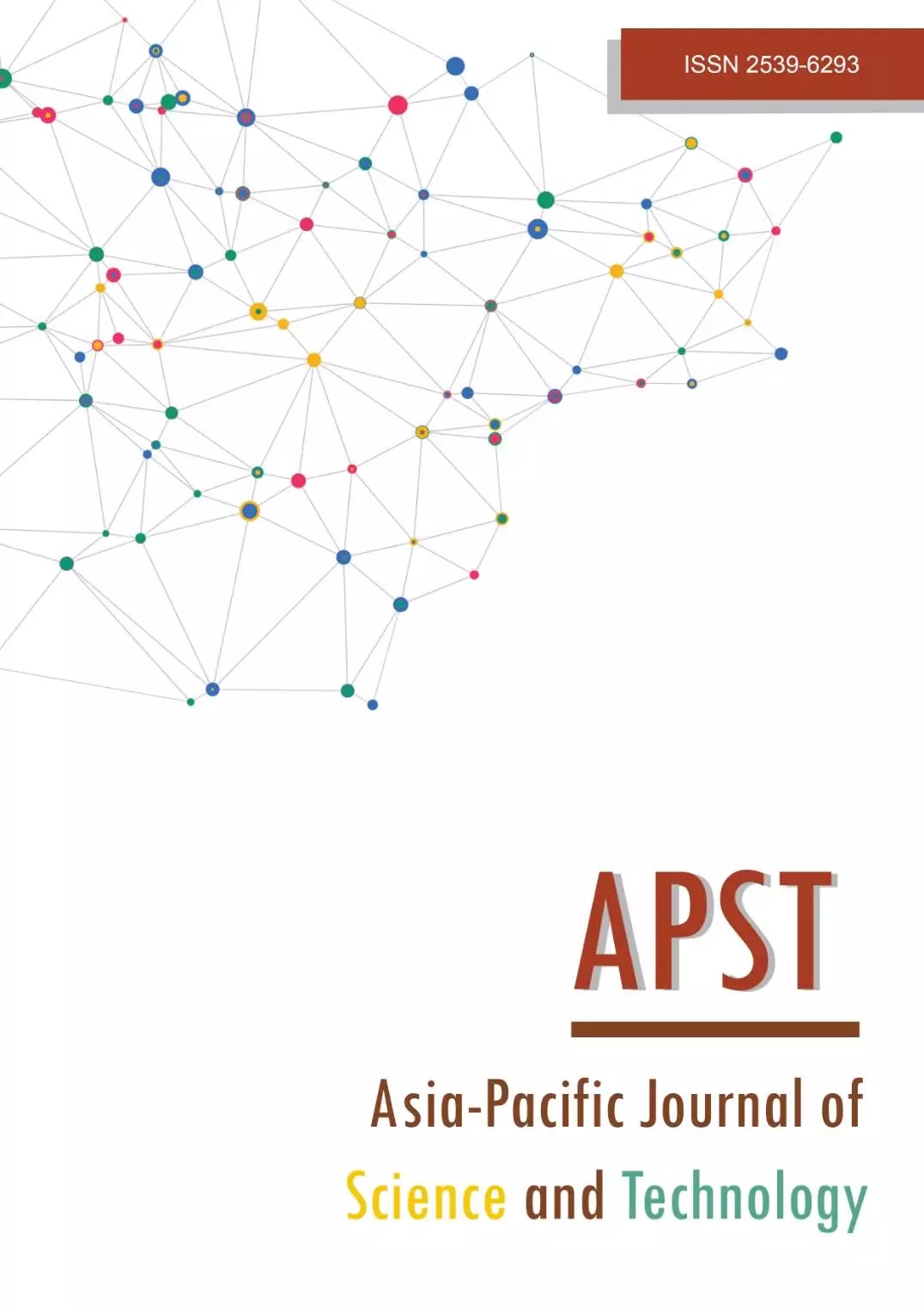Anti-α-glucosidase and anti-inflammatory activities of fatty acid, fatty acid ester, and phytosterol compounds from papaya (Carica papaya L.) seed extracts
Main Article Content
Abstract
Papaya (Carica papaya L.) is a popular fruit in Thailand with numerous health benefits owing to its high content of vitamins and enzymes, which are associated with the prevention and treatment of gastrointestinal tract disorders. Papaya seeds are considered as agricultural waste, and the information about the bioactive compounds is limited by the currently available identification techniques. This study determined the chemical components present in the oil extracts of the Holland papaya seeds. The anti-α-glucosidase activity and nitric oxide accumulation, which are associated with the anti-inflammatory properties, were detected. Gas Chromatography-Mass Spectrometry (GC-MS) was used to identify the chemical components in the hexane and ethyl acetate seed extracts. As a result, abundant bioactive compounds, which could be categorised into three groups based on their structure, including phytosterol compounds, fatty acid esters and fatty acids, were detected in the papaya seed oil extracts. Additionally, the extracts produced good inhibitory effects on α-glucosidase, whereas the hexane extract exhibited anti-inflammatory properties without causing toxicity to cell lines. This study provides valuable information that could be potentially useful for increasing the value of agricultural and industrial papaya seed waste in the future.
Article Details

This work is licensed under a Creative Commons Attribution-NonCommercial-NoDerivatives 4.0 International License.
References
Afolabi IS, Ofobrukweta K. Physicochemical and nutritional qualities of Carica papaya seed products. J Med Plant Res. 2011;5:3113-3117.
Singh SP, Kumar Sanjay, Mathan SV, Tomar MS, Singh RK, Verma PK, Kumar A, Kumar S, Singh RP, Acharya A. Therapeutic application of Carica papaya leaf extract in the management of human diseases. J Pharm Sci. 2020;28(2):735-744.
Nguyen TTT, Shaw PN, Parat MO, Hewavitharana AK. Anticancer activity of Carica papaya: a review. Mol Nutr Food Res. 2013;57(1):153-164.
Kumar NS, Devi SP, Kumar NS. The surprising health benefits of papaya seeds: a review. J Pharmacogn Phytochem. 2017;6(1):424-429.
Kong Y.R., Jong Y.X., Balakrishnan M., Bok Z.K., Weng J.K.K., Tay K.C., et al. Beneficial role of Carica papaya extracts and phytochemicals on oxidative stress and related diseases: a mini review. Biology. 2021;10:287.
Wijesooriya A.A., Deraniyagala S.A. and Hettiarachchi C.M. Antioxidant, anti-inflammatory and antibacterial activities of the seeds of a Sri Lankan variety of Carica papaya. Biomed Pharmacol J. 2019; 12(2):539-547.
Kermanshai R, Mccarry BE, Rosenfeld J, Summers PS, Weretilnyk EA, Sorger GJ. 2001. Benzyl isothiocyanate is the chief or sole anthelmintic in papaya seed extracts. Phytochemistry. 2001;57(3):427-35.
Akujobi CN, Ofodeme CN, Enweani CA. Determination of antibacterial activity of (Paw Paw) extracts Carica papaya. Niger J Clin Pract. 2010;13(1):55-57.
Peter JK, Kumar Y, Pandey P, Masih H. Antibacterial activity of seed and leaf extract of Carica Papaya var. Pusa dwarf Linn. IOSR J Pharm Biol Sci. 2014;9(2):29-37.
Zhou K, Wang H, Mei W, Li X, Luo Y, Dai H. Antioxidant activity of papaya seed extracts. Molecules. 2011;16(8):6179-6192.
Sugiharto S. Papaya (Carica papaya L.) seed as a potent functional feedstuff for poultry - a review. Vet World. 2020;13(8):1613-1619.
Amin AH, Bughdadi FA, Abo-Zaid MA, Ismail AH, El-Agamy SA, Alqahtani A, et al. Immunomodulatory effect of papaya (Carica papaya) pulp and seed extracts as a potential natural treatment for bacterial stress. J Food Biochem. 2019;43(12):e13050.
Muhamad SAS, Jamilah B, Russly AR, Faridah A. The antibacterial activities and chemical composition of extracts from Carica papaya cv. Sekaki/Hong Kong seed. Int Food Res J. 2017;24(2):810-818.
Nayak BS, Ramdeen R, Adogwa A, Ramsubhag A, Marshall JR. Wound-healing potential of an ethanol extract of Carica papaya (Caricaceae) seeds. Int Wound J. 2012;9(6):650-655.
Prasetya AT, Mursiti S, Maryan S, Jati NK. Isolation and identification of active compounds from papaya plants and activities as antimicrobial. IOP Conf Ser: Mater Sci Eng. 2018;349:1-5.
Matsui T, Yoshimoto C, Osajima K, Oki T, and Osajima Y. In vitro survey of -glucosidase inhibitory food components. Biosci Biotechnol Biochem. 1996;60(12):2019-2022.
Atiq-ur R, Latif A, Abbas N, Waheed I, Atta-ur-Rehman, Qaisar, M.N. Alpha-glucosidase inhibitory and antioxidant activities of various extracts of aerial parts of Fagonia indica Burm. F. Trop J Pharm Res. 2018;18(4):791-797.
Berkels, R., Purol-Schnabel, S., Roesen, R. Measurement of nitric oxide by reconversion of nitrate/nitrite to NO. Methods Mol. Biol. 2004;279:1-8.
He X, Ma Y, Yi G, Wu J, Zhou L, Guo H. Chemical composition and antifungal activity of Carica papaya Linn. seed essential oil against Candida spp. Lett. Appl. Microbiol. 2017;64:350-354.
Sofi FR, Raju Cv, Lakshmisha IP, Singh RR. Antioxidant and antimicrobial properties of grape and papaya seed extracts and their application on the preservation of Indian mackerel (Rastrelliger kanagurta) during ice storage. J Food Sci Technol. 2016;53(1):104-117.
Yoshida Y, Niki E. Antioxidant effects of phytosterol and its components. J Nutr Sci Vitaminol. 2003;49(4):277-280.
Teng H, Chen L. α-Glucosidase and α-amylase inhibitors from seed oil: a review of liposoluble substance to treat diabetes. Crit Rev Food Sci Nutr. 2017;57(16):3438-3448.
Nguyen T.H. and Kim S.M. α-Glucosidase Inhibitory Activities of fatty acids purified from the internal organ of sea cucumber Stichopus japonica. J Food Sci. 2015;80(4):841-847.
Su C.H., Hsu C.H. Ng L.T. Inhibitory potential of fatty acids on key enzymes related to type 2 diabetes. IUBMB Life. 2013;39(4)415-421.
Hellmann J, Zhang MJ, Tang Y, Rane M, Bhatnagar A, Spite M. Increased saturated fatty acids in obesity alter resolution of inflammation in part by stimulating prostaglandin production. J Immunol. 2013;191(3):1383-1392.
Pandey S, Cabot PJ, Shaw PN, Hewavitharana AK. Anti-inflammatory and immunomodulatory properties of Carica papaya. J Immunotoxicol. 2016;13(4):590-602.
Sander WJ, O’Neill HG, Pohl CH. Prostaglandin E2 As a modulator of viral infections. Front Physiol. 2017;8:89.
Kumsaiyai W, Khamlue P, Panyasak D, Punturee K. Different effects of palmitic and oleic acid on LPS induced nitric oxide production and its association with intracellular lipid accumulation. J Assoc Med Sci. 2019;52(1):8-13.


